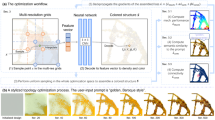Abstract
Computer screens are rich in discontinuous-tone content besides traditional continuous-tone content. Thus, new video coding tools coherently united into traditional hybrid coding tools are needed to effectively compress screen contents. This paper proposes a Pseudo-2D-matching (P2M) coder based enhancement to High Efficiency Video Coding for screen contents. An input Largest Coding Unit (LCU) is simultaneously fed into a P2M coder and a traditional hybrid coder. The coder minimizing rate-distortion is selected as the final coder for the LCU. The P2M coder breaks an LCU into many horizontal or vertical line segments and searches matching line segments in the searching-window consisting of previously coded pixels. Since the searching-window is large (a few kilobytes to megabytes) to increase the chance to find a good matching, a hash-table is used to speedup the search. In the P2M coder, three matching modes are used: 1) vertically scanned string matching; 2) horizontally scanned 2D-shape-preserved matching; and 3) vertically scanned 2D-shape-preserved matching. All three matching modes are used to code an LCU and the mode minimizing rate-distortion is selected in the P2M coder. The P2M based enhancement achieves significant Bitrate-distortion rate (BD-rate) and subjective visual quality improvement over traditional hybrid coding for screen contents.










Similar content being viewed by others
References
Bjøntegaard G (2001) Calculation of average PSNR differences between RD-Curves. ITU-T SG16 Q.6 document, VCEG-M33
Bjøntegaard G (2001) Improvements of the BD-PSNR model. ITU-T SG16 Q.6 document, VCEG-AI11
Cao J, Zhou K, Wang S and Lin T (2012) YUV4:4:4 test sequences for screen content coding. JCT-VC Doc JCTVC-H0294
Chen X, Lin T, Zhang P, Wang S and Zhou K (2012) R-D cost based effectiveness analysis of Dual-coder Mixed Chroma-sampling-rate (DMC) coding for 4:4:4 screen content. JCT-VC Doc JCTVC-J0353
Flynn D (2012) Common test conditions and software reference configurations for HEVC range extensions. JCT-VC Doc JCTVC-K1006
Lan C, Peng X, Xu J and Wu F (2011) Intra and inter coding tools for screen contents. JCT-VC Doc JCTVC-E145
Lan C, Shi G, Wu F (2010) Compress Compound Images in H.264/MPGE-4 AVC by Exploiting Spatial Correlation. IEEE Trans Image Process 19(4):946–957
Lin T, Hao P (2005) Compound image compression for real-time computer screen image transmission. IEEE Trans Image Process 14(8):993–1005
Lin T and Wang S-h (2009) Cloudlet-screen computing: a multi-core-based, cloud-computing-oriented, traditional-computing-compatible parallel computing paradigm for the masses. In: IEEE workshop on multimedia signal processing and novel parallel computing. New York, pp 1805–1808
Lin T and Wang S (2012) Mixed chroma sampling-rate coding: combining the merits of 4:4:4 and 4:2:0 and increasing the value of past 4:2:0 investment. JCT-VC Doc JCTVC- H0065
Lin T, Wang S, Zhang P and Zhou K (2012) Full-chroma (YUV444) dictionary+hybrid dual-coder extension of HEVC. JCT-VC Doc JCTVC-K0133
Lin T, Wang S, Zhang P and Zhou K (2013) P2M based dual-coder extension of HEVC. JCT-VC Doc JCTVC-L0303
Lin T, Zhang P, Wang S and Zhou K (2012) 4:4:4 Screen content coding using Dual-coder Mixed Chroma-sampling-rate (DMC) Techniques. JCT-VC Doc JCTVC- I0272
Lin T, Zhang P, Wang S, Zhou K and Chen X (2012) Syntax and semantics of Dual-coder Mixed Chroma-sampling-rate (DMC) coding for 4:4:4 screen content. JCT-VC Doc JCTVC-J0233
Lin T, Zhang P, Wang S, Zhou K, Chen X (2013) Mixed chroma sampling-rate high efficiency video coding for full-chroma screen content. IEEE Trans Circ Syst Video Technol 23(1):173–185
Lin T, Zhou K and Wang S (2013) Cloudlet-screen computing: a client–server architecture with top graphics performance. Int J Ad Hoc and Ubiquitous Computing 12(2)
Pang C, Sole J, Guo L, Karczewicz M and Joshi R (2013) Non-RCE3: intra motion compensation with 2-D MVs. JCT-VC Doc JCTVC-N0256
Shu-hui Wang and Lin T (2010) United coding for compound image compression. In: 3nd international conference on image and signal processing. Yantai, pp 566–570
Wang S-h and Tao Lin (2009) A Unified LZ and hybrid coding for compound image partial-lossless compression. In: 2nd international conference on image and signal processing. Yantai, pp 1–5
Wang S and Lin T (2012) 4:4:4 screen content coding using macroblock-adaptive mixed chroma-sampling-rate. JCT-VC Doc JCTVC-H0073
Wang S, Lin T and Zhou K (2012) Update on full-chroma (YUV444) screen content test sequences of JCTVC-H0294. JCT-VC Doc JCTVC-K0207
Wang S, Lin T and Zhou K (2013) YUV444 and RGB screen content test sequences. JCT-VC Doc JCTVC-L0317
Yan L, Li S, Shen H (2011) Virtualized screen: a third element for cloud_mobile convergence. IEEE Multimedia 18(2):4–11
Zhang P, Lin T, Chen X, Wang S and Zhou K (2012) BD-rate performance vs. dictionary size and hash-table memory size in Dual-coder Mixed Chroma-sampling-rate (DMC) coding for 4:4:4 screen content. JCT-VC Doc JCTVC-J0352
Zhang P, Lin T, Wang S and Zhou K (2012) Subjective quality comparison between DMC coding and chroma-subsampled 420 coding using YUV444 screen content test sequences. JCT-VC Doc JCTVC-I0336
Zhou M, Gao W, Jiang M, Yu H (2012) HEVC Lossless Coding and Improvements. IEEE Trans Circ Syst Video Technol 22(12):1839–1843
Acknowledgments
This work was supported in part by NSFC under Grant No. 61201226 and Grant No. 61271096, the Natural Science Foundation of Shanghai under Grant No. 12ZR1433800, China university doctorial special funding project under Grant No. 20130072110054 and the Fundamental Research Funds for the Central Universities of China under Grant No. 2810219002 and Grant No. 2810219003.
Author information
Authors and Affiliations
Corresponding author
Rights and permissions
About this article
Cite this article
Wang, S., Lin, T., Zhou, K. et al. Pseudo-2D-matching based enhancement to high efficiency video coding for screen contents. Multimed Tools Appl 74, 7753–7771 (2015). https://doi.org/10.1007/s11042-014-2021-3
Received:
Revised:
Accepted:
Published:
Issue Date:
DOI: https://doi.org/10.1007/s11042-014-2021-3




